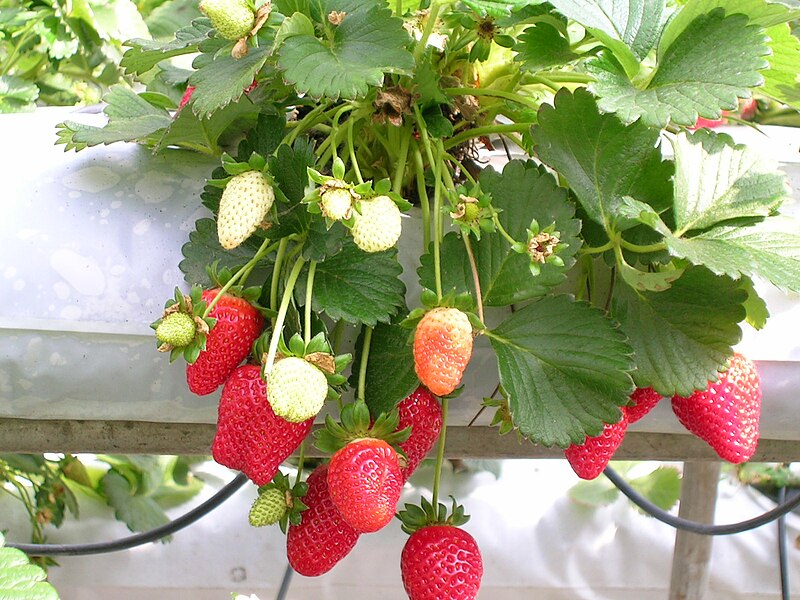This thread can be ignored.
11 posts
• Page 1 of 2 • 1, 2

The potato is a starchy, tuberous crop fruit from the perennial Solanum tuberosum of the Solanaceae family. Potato may refer to the plant itself as well. In the region of the Andes, there are some other closely related cultivated potato species. Potato is the world's most widely grown tuber crop, and the fourth largest food crop in terms of fresh produce after rice, wheat, and corn.
Wild potato species occur from the United States to Uruguay and Chile. Genetic testing of the wide variety of cultivars and wild species suggest that the potato has a single origin in the area of southern Peru, from a species in the Solanum brevicaule complex. Today, over 99% of all cultivated potatoes worldwide are descendants of a subspecies indigenous to south-central Chile. Based on historical records, local agriculturalists, and DNA analyses, the most widely cultivated variety worldwide, Solanum tuberosum tuberosum, is believed to be indigenous to Chiloé Archipelago where it was cultivated by the indigenous people.
The potato was introduced to Europe in 1536, and subsequently by European mariners to territories and ports throughout the world. Thousands of varieties persist in the Andes, where over 100 varieties might be found in a single valley, and a dozen or more might be maintained by a single agricultural household. Once established in Europe, the potato soon became an important food staple and field crop. But lack of genetic diversity, due to the fact that very few varieties were initially introduced, left the crop vulnerable to disease. In 1845, a plant disease known as late blight, caused by the fungus-like oocmycete Phytophthora infestans, spread rapidly through the poorer communities of western Ireland, resulting in the crop failures that led to the Great Irish Famine.
The annual diet of an average global citizen in the first decade of the twenty-first century would include about 33 kilograms (or 73 lbs.) of potato. However, the local importance of potato is extremely variable and rapidly changing. The potato remains an essential crop in Europe (especially eastern and central Europe), where per capita production is still the highest in the world, but the most rapid expansion of potato over the past few decades has occurred in southern and eastern Asia. China is now the world’s largest potato producing country, and nearly a third of the world’s potatoes are harvested in China and India. More generally, the geographic shift of potato production has been away from wealthier countries toward lower-income areas of the world.
-

Doom - Posts: 296
- Joined: Sun Aug 10, 2008 11:15 pm

Apium graveolens is used around the world as a vegetable, either for the crisp petiole or the fleshy taproot.
In temperate countries, celery is also grown for its seeds, which are very small fruit rather than actual seeds, which yield a valuable volatile oil used in the perfume and pharmaceutical industries. It also contains an organic compound called apiol. Celery seeds can be used as flavouring or spice either as whole seeds or, ground and mixed with salt, as celery salt. Celery salt can also be made from an extract of the roots. Celery salt is used as a seasoning, in cocktails, on the Chicago-style hot dog, and in Old Bay Seasoning.
Celery, onions, and bell peppers are the holy trinity of Louisiana Creole and Cajun cuisine. Celery, onions, and carrots make up the French mirepoix, often used as a base for sauces and soups. Celery is a staple in chicken noodle Soup. Celery is an important ingredient in Indian cuisines including in Indian Curry. Celery is also good with peanut butter.
- EuroVen
- Posts: 88
- Joined: Fri Aug 08, 2008 10:06 pm

Rice is a cereal foodstuff which forms an important part of the diet of many people worldwide and as such it is a staple food for many.
Domesticated rice comprises two species of food crops in the Oryza genus of the Poaceae ("true grass") family, Oryza sativa and Oryza glaberrima. Oryza sativa is native to tropical and subtropical southern Asia and African rice, Oryza glaberrima, is native to West Africa.
The name wild rice is usually used for species of the different but related genus Zizania, both wild and domesticated, although the term may be used for primitive or uncultivated varieties of Oryza.
Rice is grown as a monocarpic annual plant, although in tropical areas it can survive as a perennial and can produce a ratoon crop and survive for up to 20 years. Rice can grow to 1–1.8 m tall, occasionally more depending on the variety and soil fertility. The grass has long, slender leaves 50–100 cm long and 2–2.5 cm broad. The small wind-pollinated flowers are produced in a branched arching to pendulous inflorescence 30–50 cm long. The edible seed is a grain (caryopsis) 5–12 mm long and 2–3 mm thick.
Rice is a staple food for a large part of the world's human population, especially in tropical Latin America, and East, South and Southeast Asia, making it the second-most consumed cereal grain. A traditional food plant in Africa, Rice has the potential to improve nutrition, boost food security, foster rural development and support sustainable landcare. Rice provides more than one fifth of the calories consumed worldwide by humans. In early 2008, some governments and retailers began rationing supplies of the grain due to fears of a global rice shortage.
Rice cultivation is well-suited to countries and regions with low labor costs and high rainfall, as it is very labor-intensive to cultivate and requires plenty of water for cultivation. On the other hand, mechanized cultivation is extremely oil-intensive, more than other food products with the exception of beef and dairy products. Rice can be grown practically anywhere, even on a steep hill or mountain. Although its species are native to South Asia and certain parts of Africa, centuries of trade and exportation have made it commonplace in many cultures.
The traditional method for cultivating rice is flooding the fields with or after setting the young seedlings. This simple method requires sound planning and servicing of the water damming and channeling, but reduces the growth of less robust weed and pest plants that have no submerged growth state, and deters vermin. While with rice growing and cultivation the flooding is not mandatory, all other methods of irrigation require higher effort in weed and pest control during growth periods and a different approach for fertilizing the soil.
-

Dark Lucario - Posts: 126
- Joined: Sat Aug 09, 2008 12:57 am

Garden strawberries are a common variety of strawberry cultivated worldwide. Like other species of Fragaria (strawberries), it belongs to the family Rosaceae. Technically it is not a fruit although it is known as an accessory fruit, in that the fleshy part is derived not from the plant's ovaries (achenes) but from the peg at the bottom of the bowl-shaped hypanthium that holds the ovaries.
The Garden Strawberry was first bred in Europe in the early 18th century. This represents the accidental cross of Fragaria virginiana from eastern North America, which was noted for its flavor, and Fragaria chiloensis from Chile, which was noted for its large size.
Cultivars of Fragaria × ananassa have replaced in commercial production the Woodland Strawberry, which was the first strawberry species cultivated in the early 17th century.
Strawberries are the only fruit that have seeds embedded in the skin.
The strawberry is an accessory fruit; that is, the fleshy part is derived not from the ovaries which are the "seeds" (actually achenes) but from the peg at the bottom of the hypanthium that held the ovaries. So from a technical standpoint, the seeds are the actual fruits of the plant, and the flesh of the strawberry is modified receptacle tissue. It is whitish-green as it develops and in most species turns red when ripe. All strawberries have seeds that are visible from the outside.
Wild Strawberries
According to the US Forest Service, wild strawberries are often edible and even have medicinal value. Western Indians made a tea from the green leaves of the wild strawberry plant. They also used the tiny, sweet fruit of the strawberry.
Before anyone even knew about Vitamin C, Indians ate wild strawberries to help with colds. Juice from the wild strawberry was combined with water and used to soothe reddened eyes. This juice was also poured into inflamed sores and sometimes had healing effects. It was also used to relieve sunburns. A tea made from dried strawberry plant leaves was used for kidney trouble and helped relieve stomach trouble.
Drinking a tea made from the fresh green foliage of the wild strawberry saved many Minutemen in the American Revolution from scurvy.
Indians made bitters from wild strawberry roots and used it as a tonic and blood purifier after a cold, long winter. Wild strawberries were mashed up into a paste to clean teeth, remove tartar, and soothe toothaches.
Wild strawberry plants can be found from the lowest valleys to timberline in moist soils of woods, open meadows and along streams.
-

NikkyVix - Site Admin
- Posts: 1296
- Joined: Thu Aug 07, 2008 9:14 pm
- Location: Behind a doorway. Setting traps.

Slime mold is a strange kind of fruit, and despite it's icky name is actually quite tasty.
It's have various names depending on who you ask, such as grapes, pizza, cake, yiff and spooge, but Slime Mold is definatly the most common name. The fruit is eaten raw and unlike corpses you find in the dungeon, it doesn't rot and is always safe to eat.
It fulfills 250 nutritional points, being one of the more filling foods you can find in dungeons of doom.
-

Purplecat - Site Admin
- Posts: 2067
- Joined: Thu Aug 07, 2008 6:49 pm
- Location: Sweden, Höganäs
The thread will not be deleted as requested. Perhaps we all need to learn to go along with the flow for silliness' sake and to learn to laugh at ourselves as well.
-

Witchiebunny - Posts: 755
- Joined: Thu Aug 07, 2008 6:43 pm
- Location: In her burrow. Drinking Tea. Earl Grey. Hot.
If this thread was meant for silliness it would have been posted in Off Topic or TF2 Fun.
This thread only goes to show how unhelpful people in power can be towards someone who's trying to improve. I bet you all get a kick out of this but it's no different than a *chan thread, in here.
An alternate thread has been created and I expect serious responses to the serious questions. Failure to do so will result in another alternate thread being made until my questions and concerns are answered in a meaningful fashion.
I don't care if you guys are taking this matter lightly and ridiculing it. Show some respect.
This thread only goes to show how unhelpful people in power can be towards someone who's trying to improve. I bet you all get a kick out of this but it's no different than a *chan thread, in here.
An alternate thread has been created and I expect serious responses to the serious questions. Failure to do so will result in another alternate thread being made until my questions and concerns are answered in a meaningful fashion.
I don't care if you guys are taking this matter lightly and ridiculing it. Show some respect.
-

Echoen - Posts: 162
- Joined: Thu Aug 07, 2008 8:15 pm
-

NikkyVix - Site Admin
- Posts: 1296
- Joined: Thu Aug 07, 2008 9:14 pm
- Location: Behind a doorway. Setting traps.
-

Witchiebunny - Posts: 755
- Joined: Thu Aug 07, 2008 6:43 pm
- Location: In her burrow. Drinking Tea. Earl Grey. Hot.
11 posts
• Page 1 of 2 • 1, 2
Who is online
Users browsing this forum: No registered users and 15 guests




